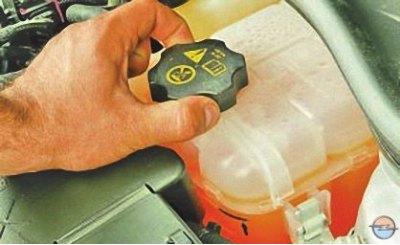Notes:
- The manufacturer recommends the use of coolant (antifreeze) based on ethylene glycol.
- Do not mix liquids of different colors and different manufacturers. If you need to add coolant, but you do not know the brand of liquid filled into the system, replace all the liquid in the cooling system.
- Only use products from trusted manufacturers. Remember that the use of poor quality coolant leads to costly engine repairs!
- Place the vehicle on a level surface before starting work.
Attention!
- Check the coolant level only on a cold engine.
- The coolant is toxic, so be careful when handling it.
- Do not pour liquid into the tank much higher than the mark «KALT/COLD», because when the engine is running, its volume will increase.
- When starting the engine, the cap of the expansion tank must be tightly closed.
Helpful Hints:
- Keep an eye on the coolant level at all times. Its sharp decrease or increase should be a signal for an immediate check of the engine cooling system.
- If the freshly poured antifreeze suddenly suddenly quickly changed color to brown, then you were sold a fake, in which «forgot» add corrosion inhibitors. Replace the fluid as soon as possible before it has had time to corrode the cooling system.

The expansion tank is installed in the engine compartment on the left side.

1. The coolant level with a cold engine should be slightly above the mark «KALT/COLD», applied to the wall of the expansion tank.

2. To add fluid, unscrew the plug of the expansion tank..

3.... and add coolant to the required level.

4. Wrap a stopper of a broad tank.
Attention! Screw the cap on the expansion tank tightly. When the engine is running, the expansion tank is under pressure, so coolant may leak from under a loosely wrapped plug or the plug may be torn off.

Visitor comments